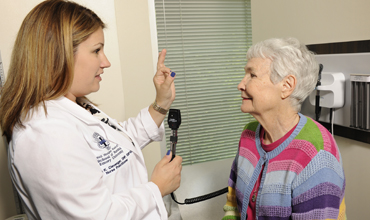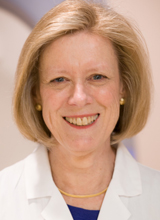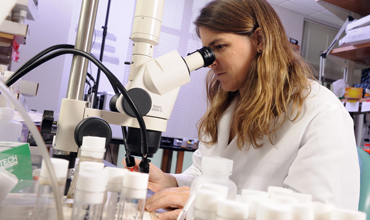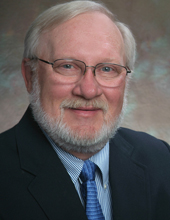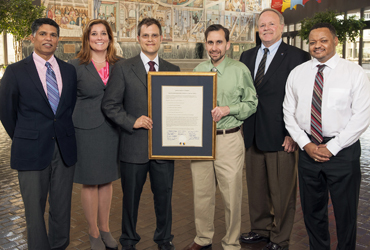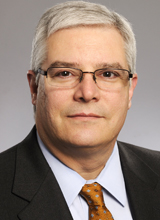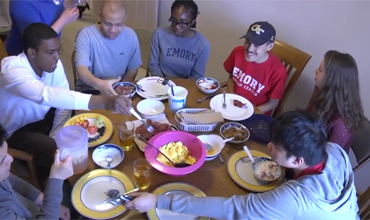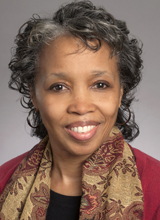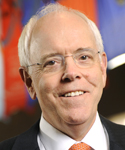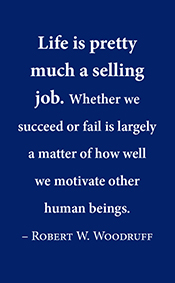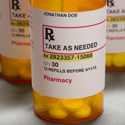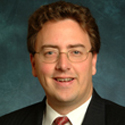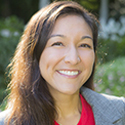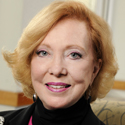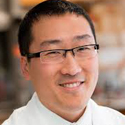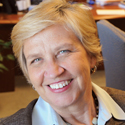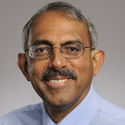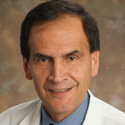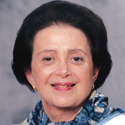
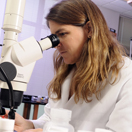 Reasons behind the ranking Reasons behind the ranking |
 Holding each other accountable Holding each other accountable |
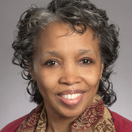 Teaching life skills to adults with autism Teaching life skills to adults with autism |
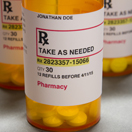 In brief In brief |
| April 21, 2015 | ||||||||||||||||||||||||
Centralizing care for dementia patients
Caring for a family member with dementia is complex and highly stressful. Consider the Alzheimer's patient who behaves erratically when his blood sugar level spikes or plummets in the course of a day. It's not up to the neurologist to manage the patient's diabetes. And the patient's primary care physician can't see him until next week. The new Integrated mEmory Care Clinic aims to help in such cases by providing dementia and primary care services in one place. It is located within the Memory Disorders Clinic at 12 Executive Park. Both are part of the Emory Brain Health Center, which opened last year and is set to launch officially later this month. (Stay tuned for more details on this coming soon.) The Integrated mEmory Care Clinic, which is run by nurse practitioners, is essentially a "medical home" for dementia patients, where nurse specialists provide high-quality continuity of care at low cost. It is the brainchild of the Nell Hodgson Woodruff School of Nursing and the Department of Neurology and is funded by $1 million gifts to each from two different anonymous donors. The Emory Palliative Care Center and the Division of General Medicine and Geriatrics also play significant roles at the clinic. Clinic nurses are seeing their first cohort of patients from the Memory Disorders Clinic and plan to grow their patient base in waves, drawing next from throughout Emory Healthcare and then the general public. Patients must live no farther than an hour's drive away. "We're just starting to develop a critical mass of patients," says Carolyn Clevenger, clinic director and nursing school faculty member. "That's going to take time. It will take us about three years to reach the break-even point." The idea for the clinic evolved out of concern for patients and family members who must navigate getting to and from appointments with multiple providers and who need help in prioritizing numerous tests and treatments.
"One issue for families is looking at patient care through the prism of a dementia diagnosis," says Janet Cellar, a clinical nurse specialist in geriatric psychiatry and clinic project director. "Do you really need to be aggressive about services such as mammograms and colonoscopies when a patient is severely impaired?" The team that Cellar co-leads provides expertise in several areas. They include NPs in geriatrics, neurology, geriatric psychiatry, and palliative care; a care coordinator RN; a clinical social worker; and four patient-family advisers. Physicians Allan Levey and Ihab Hajjar provide backup in cognitive neurology and geriatrics, respectively. "Our goal is to see a patient within 24 hours of a request," says Cellar. "If a family caregiver calls in the morning, we can see the patient that same day. We're also on call 24/7, so the caregiver can reach one of us directly if they have an issue in the middle of the night." The nurses recently saved a trip to the clinic for a dementia patient with a urinary tract infection. They coached her caregiver by phone on how to relieve symptoms with rehydration and checked back later to see how the patient was faring. "What we've heard from patients and families is that they want to understand how dementia works and that we have a plan for dealing with it," says Clevenger. "We can't totally relieve the caregiver burden. But we can educate families about what to expect as the dementia progresses and how to deal with issues like UTIs, which can affect a patient's behavior. Having one place where providers understand how to deal with both dementia and primary care needs is a great service to families."—Pam Auchmutey For appointments, call the Integrated mEmory Care Clinic at 404-712-6929. Reasons behind Emory's top rank for grad student predoc fellowships
Emory was cited recently for its topmost rank in the nation for its number of students holding "F31" NIH grants, fellowships that support predoctoral graduate students. Of the 50 students who currently hold such grants, all programs in the Laney Graduate School's Graduate Division of Biological and Biomedical Science (GDBBS) are represented, including MD/PhD students as well as nursing, public health, and psychology doctoral students. The ranking highlights years of nurturing a culture here that seeks to educate students in writing, presenting, and otherwise communicating effectively about their research. Biochemist Anita Corbett, who directs writing courses for several graduate programs, sums up the reasons behind the rankings: "We have excellent trainees and faculty sponsors, we have lots of support from GDBBS and the graduate school, and we require formal training in scientific writing for second-year graduate students." The purpose of the "grants course," which goes by different names in different GDBBS programs, is two-fold: to prepare students for their qualifying exams and to introduce them to the precise, rigorous thinking and writing needed to produce a competitive grant application.
"Most students say it's one of the best things they've had to do here, and the hardest," says Keith Wilkinson, GDBBS director. Biochemist Rick Kahn, together with Ken Bernstein (now at Cedars-Sinai in Los Angeles), first developed a required course called "Hypothesis Design and Scientific Writing" for the biochemistry, cell and developmental biology program in the late 1990s. Kahn went on to implement a similar course for the neuroscience program, and now all GDBBS programs offer something similar. "We really consider it a writing course," says Yerkes neuroscientist Lisa Parr, who has been teaching the neuroscience graduate program's class for several years. "The students learn to put together a research proposal in the NIH format and how to support it by designing the best experiments. I try to emphasize to the students how to think about the grant application from the reviewer's standpoint." Occasionally, says Wilkinson, students push back against having to learn to write a grant application when their postdoctoral plans focus on industry. "I remind them, 'The game is the same, no matter where you end up working,'" he says. "Someone else has the money, and you have to convince them to give it to you. It's valuable to learn how to ask for support and justify what you want to do."—Quinn Eastman Holding each other accountable
When a group from the Woodruff Leadership Academy's class of 2014 presented their class project, "Evaluating the Efficacy of the Emory Healthcare Pledge," to Woodruff Health Sciences Center leadership last year, WHSC Board Chair Doug Ivester found their conclusions compelling. He invited them to present an abbreviated version before the entire WHSC Board at its meeting last November. The result: board members recently signed a resolution (framed in photo above, to be displayed in WHSCAB) endorsing the pledge, adopting it as a guide to their own conduct, and advocating its adoption and promulgation throughout the entire health sciences center. Some background: The EHC Pledge was inaugurated in Emory Healthcare in 2011 as a defining influence on standards of behavior and communication throughout the organization, starting at the top. The pledge is short and simple, articulating a basic, commonsense, do-unto-others philosophy, but it is also highly powerful—and very challenging—to live by day to day. It gave implicit permission for employees at any level to speak up when they perceived an impending error in a patient procedure or to summon a medical emergency team (code MET) when they thought a patient was in distress. And it was seen as vital to creating a "fair and just" culture in which patient safety and quality of care reign supreme in everyone's minds. In carrying out their project, members of the WLA "Oath Takers" team, which included two surgeons, a critical care nursing director, a public health faculty member, and a physician faculty member in psychiatry, first explored best practices of other organizations, both health care and non-health care, that had implemented successful culture-changing codes of conduct. They also surveyed employees to benchmark how well Emory's pledge had permeated the culture so far and the effect it was perceived as having on behavior. Although the vast majority of EHC employees (90%) had at least heard of the pledge, the degree of engagement was variable, and the WLA group, not surprisingly, found opportunities for improvement. In their executive summary, they recommended more training and resources to ensure the pledge's full potential and benefits to the culture. No one could agree more that the pledge needs wider and deeper dissemination than pledge champion Hal Jones, who directs culture in the medical school and was founding director of care transformation in Emory Healthcare (an office now led by Michelle Gray). "Taking the pledge is just the first step and the easy part," he says. "The more challenging part is actually holding each other accountable, in a caring and supportive way, when we've perceived others interacting with us or team members in a manner inconsistent with our pledge." Jones conducts training on how to have constructive "cup-of-coffee" conversations to learn from these situations: I'd like to talk to you about the interaction we had yesterday…
According to Jones, efforts to promulgate the pledge throughout the WHSC are already under way. Emory CEPAR administrator Sam Shartar leads the WHSC's Diversity Committee, which is developing a plan for implementing the pledge among WHSC leadership and staff. "We are defining benefits of adopting the pledge in non-clinical settings to ensure ethical conduct of research, for example, optimize business efficiencies, and improve the culture of teamwork, service to others, safety, job satisfaction, transparency, and ability to resolve conflicts successfully," he says. "We are developing university-oriented vignettes, identifying trained resources to assist employees, and creating a culture that allows for collegial discussion of concerns." Please note: The EVPHA office has produced laminated, pocket-size copies of the pledge, which can be obtained from William Payne. Related: Read about how pledge culture has influenced initiatives to teach compassion in the medical school and a personal story about patient safety from WLA group member and urologic surgeon Viraj Master. Helping adults with autism practice basic life skills
The Emory Autism Center is making use of the Emory campus for an initiative to help adults with autism spectrum disorder learn and practice important life skills. The pilot program, called myLIFE, provides opportunities for young adults with autism (18 and older) to address issues that are important for independent living, including interaction with other people, communicating their needs, participating in community events, engaging in health-related activities, and getting around on public transportation.
"Studies show that people with autism spectrum disorder learn more about life when interacting with people their own age who do not have the same challenges," explains Toni Thomas, program manager for adult services at the Emory Autism Center. "That’s one of the reasons we decided to make use of the Emory environment and availability of educated volunteers to help each myLIFE group member learn the skills they need to participate in age-appropriate activities with their peers." Program participants are being exposed to a variety of responsibilities: - An apartment on the Emory campus provides a place where they can practice skills related to self-care needs, such as cooking, cleaning, and doing laundry. It also provides a comfortable place where the group can hang out for social time together and with others. - Volunteer mentors take the participants to various functions on campus, ride with them on campus shuttles, and dine with them. - Training in healthy living skills is provided by a volunteer nutritionist and students from the nursing and medical schools, and participants are required to join one of Emory's campus athletic centers, which have provided discounted passes. - Activities such as woodworking and gardening are part of the program to introduce participants to new hobbies or potential job skills. "Our goal is to provide these young adults with exposure to every life experience possible," says Thomas. This program was funded in part by a grant from the Autism Foundation of Georgia, with additional support from the Georgia Department of Behavioral Health and Developmental Disabilities. Watch a video on this program. |
| From the Executive VP
WHSC at a glance
You probably know our annual At a Glance publication, recently updated for 2015, as a valuable source of data about the size, scope, and structure of the Woodruff Health Sciences Center, and you’re certainly right. But it also represents something more—the thousands of people who work here and the tens of thousands of people they serve every year; the thousands of talented health professionals we train and the scores of community partners and affiliates who help us extend our outreach to people in need; the many millions of dollars in charity care we provide each year; and the billions of dollars in positive economic impact that we bring to metro Atlanta. Again this year, At a Glance provides comprehensive numbers and statistics on these and many other measures of WHSC’s success. And as always, they add up to an incalculable impact on human health. It may be captured in the form of a glance, but it represents a world of great people doing good for humanity. Please direct questions and comments to evphafeedback@emory.edu.
New law strengthens prescriptive authority
In March, the Georgia General Assembly passed legislation that allows the names of advanced practice registered nurses (APRNs) to be placed on the labels of the medications they prescribe. Under the new law, the word “physician” will be replaced with the word “practitioner,” thus allowing the names of APRNs, as well as physician assistants, to appear on prescription labels in Georgia for the first time. The law is scheduled to go into effect on July 1. “This provision will remove barriers in communication between patients, providers, and pharmacies and allows for the correct provider to be contacted when medication issues arise,” says MaryJane Lewitt, clinical assistant professor of nursing and chair of the Coalition of APRNs of Georgia. EHC forms ACO with Aetna
Earlier this month, Emory Healthcare and Aetna announced the formation of a new accountable care organization (ACO). The collaboration is designed to improve coordination and provision of care, leading to a better patient experience for Aetna members in Georgia, according to Patrick Hammond, CEO of the Emory Healthcare Network. The ACO with Aetna is similar to an ACO agreement between EHC and Blue Cross Blue Shield in 2013. Read more about the ACO with Aetna. Emergency and family med docs partnering with CDC on Ebola
Seven Emory physicians from emergency and family medicine have received one-year grants to provide on-site consultation, educational content, and issues management assistance to the CDC Global Migration Task Force. They will work with CDC experts to evaluate Ebola screening stations at airports, infection control precautions, Ebola preparedness and response in the maritime sector, and cost analysis of screening operations. They will also work with epidemiologists regarding contact investigation preparedness and illness response. Read more. Website eases match with clinical trials If you are interested in participating in a clinical trial, you can indicate your willingness to be contacted about relevant studies by registering at ResearchMatch.org. Read more. Notable
Three WHSC employees received Emory's 2015 Awards of Distinction: Carolyn Aidman (medicine), Stacy Heilman (medicine), and Yoko Hammond (Yerkes). Read more.
Jessica Alvarez (endocrinology) was selected to participate in the Dannon Nutrition Leadership Institute, which is aimed at early-career nutritional scientists.
Deborah Bruner (nursing) received the Distinguished Research Award from the Oncology Nursing Society. Read more.
Two Rollins School of Public Health faculty members received awards at the Association of Schools & Programs of Public Health (ASPPH) annual meeting last month: Solveig Cunningham (global health) received the Pfizer Young Investigator's Award for Distinguished Research, and Kara Brown Robinson received the 2015 ASPPH Award for Excellence in Student Services. James Curran, RSPH dean, was elected to the ASPPH Board of Directors as chair of the ASPPH Global Health Committee.
William Hu (neurology) was one of four Global Young Leaders to be invited to the 1st WHO Ministerial Conference on Global Action Against Dementia in Geneva last month. He led an international team to assemble a communique to the World Dementia Council and the World Health Assembly on four main themes related to Alzheimer's disease and related disorders: care, cure, research, and awareness.
Earlier this month, Linda McCauley, dean of nursing, participated in a White House roundtable discussion on climate change. Read more.
Venkat Narayan (RSPH, global health) received the American Diabetes Association's 2015 Kelly West Award for Outstanding Achievement in Epidemiology.
The Georgia House of Representatives, by Resolution, honored Guillermo Umpierrez (endocrinology) with the "Inspiring Mentor Award." Umpierrez directs Diabetes and Endocrinology at Grady Hospital and leads the Emory Latino Diabetes Education Program, the first nationally accredited all-Spanish diabetes education program dedicated to providing diabetes education and lifestyle intervention to Latinos in Georgia.
Nanette Wenger (cardiology) received the inaugural 2015 Bernadine Healy Leadership in Women's Cardiovascular Disease Award at the 64th Annual American College of Cardiology Scientific Session last month. Read more. Events April 30: Sixth Annual Academic & Industry Intersection Conference. 9 a.m. - 1:30 p.m. Morehouse School of Medicine. Program agenda. More info. April 30: Brain Health Center open house. 6:00-8:00 p.m., Bldg 12, Executive Park. May 17-19: BEINGS [bioethics] Summit. The Tabernacle, Atlanta. More info. May 29: 2nd Annual Advancing Healthcare Quality Research at Emory symposium. HSRB auditorium. More info. June 13-14: 4th Annual Southeastern Immunology Symposium, WHSCAB auditorium. More info.
|

